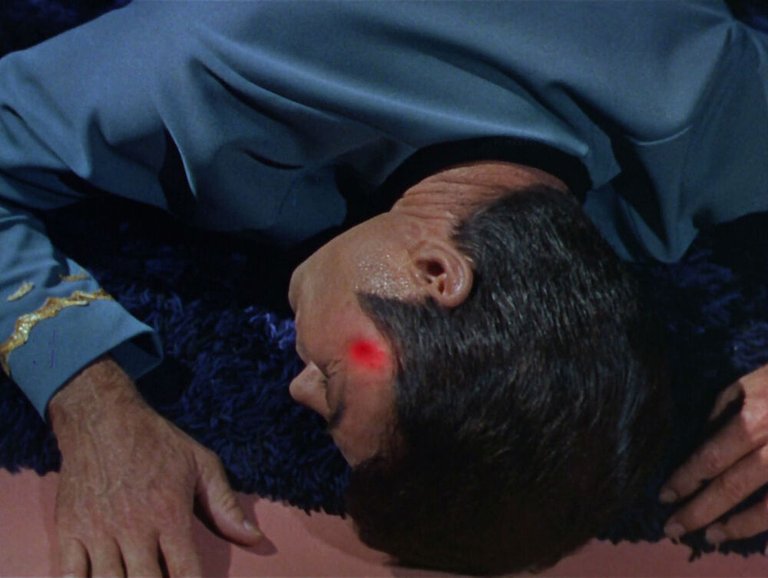Television Review: For the World Is Hollow and I Have Touched the Sky (Star Trek, S3X10, 1968)

For the World Is Hollow and I Have Touched the Sky (S03E10)
Airdate: November 8th 1968
Written by: Rik Vollaerts
Directed by: Tony Leader
Running Time: 50 minutes
The third season of Star Trek: The Original Series has long been regarded as a mixed bag, a final gasp of creativity constrained by dwindling budgets, studio interference, and the immutable structural limitations of its episodic format. By this point in the series, the show’s commitment to standalone adventures—where regular characters reset to their default states by the closing credits—had become both a strength and a glaring weakness. On one hand, this formula allowed the writers to dabble in bold, speculative concepts, unburdened by serialized storytelling. On the other, it increasingly exposed a creative stagnation, as recurring characters were denied growth or transformation, and urgent dilemmas were resolved with mechanical convenience. For the World Is Hollow and I Touched the Sky epitomises this duality. It is an episode brimming with potential, anchored by a concept that could have sustained a feature-length narrative, yet ultimately hamstrung by the very conventions that defined The Original Series. The result is a tale that oscillates between intellectual ambition and narrative timidity, leaving a lingering sense of what might have been.
The plot begins with the Enterprise intercepting a mysterious asteroid on a collision course with the inhabited planet Darran V. Initial scans reveal a crude nuclear threat, prompting a boarding party led by Kirk, Spock, and McCoy, whose recent diagnosis of xenopolycythemia—a rare, incurable disease that leaves him a year to live—casts a pall over the mission. Upon penetrating the asteroid’s surface, the crew discovers it is not a celestial body but a colossal generation ship, a relic of the Fabrini civilization, whose homeworld was consumed by a supernova. Within its hollowed interior, the descendants of the exiles have forgotten their artificial environment, worshipping a faltering supercomputer, the Oracle, as a divine entity. The narrative’s central tension arises when McCoy, confronted with his mortality, forms a bond with Natira (Kate Woodville), the high priestess, and resolves to remain behind, sacrificing his life to repair the Oracle and redirect the ship’s doomed trajectory. While the premise teases existential questions about faith, mortality, and the ethics of intervention, the execution is shackled by the episode’s need to restore the status quo: McCoy’s disease is inevitably “cured” through ancient Fabrini medical research, and the Oracle’s repairs are hastily completed, ensuring the Enterprise crew departs unscathed, unchanged.
The generation ship concept, though a staple of science fiction literature since the 1920s, was a novelty on television when this episode aired in 1968. Its depiction here—of a society adrift in a closed ecosystem, shackled by dogma—would later influence works like The Starlost (1973) and Battlestar Galactica (2004). Yet the constraints of Star Trek’s third season—particularly its shoestring budget—stifled the potential to explore the Fabrini’s culture in depth. The asteroid’s interior feels underdeveloped, offering fleeting glimpses of a civilization whose blend of ritual and technology deserved richer exposition. Similarly, McCoy’s illness and romance with Natira are introduced with emotional gravity but abandoned to narrative expediency. His vulnerability, a rare moment of introspection for the character, is undercut by the inevitability of a resolution that negates his sacrifice. The writers’ reluctance to let the Enterprise crew grapple with lasting consequences—a hallmark of Season 3—renders the stakes hollow.
Critics have frequently noted the episode’s resemblance to The Paradise Syndrome, previous Season 3 instalment in which Kirk assumes a messianic role on a primitive world. Both episodes hinge on the crew’s intervention in alien societies governed by artificial deities, yet For the World Is Hollow… distinguishes itself through its restrained conclusion. While The Paradise Syndrome ends with Kirk tragically losing a love interest, here Natira’s fate is left ambiguously hopeful, spared the same tragedy. Scriptwriter Rik Vollaerts deserves credit for avoiding melodrama, though this choice inadvertently underscores the futility of McCoy’s brief arc. His emotional turmoil, so vividly portrayed by DeForest Kelley, dissipates the moment the medical reasearch is discovered, reducing his existential crisis to a temporary inconvenience.
A subtler, more provocative layer of the episode lies in its treatment of religion. The Fabrini’s veneration of the Oracle—a decaying machine that enforces obedience through fear and misinformation—serves as a thinly veiled allegory for organised religion. The Oracle’s edicts, which suppress scientific inquiry and justify a rigid population control, mirror critiques of dogmatism leveled by secular humanists like Gene Roddenberry, who viewed traditional faiths as impediments to progress. Yet the episode stops short of explicit commentary, couching its critique in metaphor to evade the censorship that plagued 1960s television.
Director Tony Leader, in his sole Star Trek credit, navigates the episode’s limitations with competence, though his work lacks the flair of veterans like Marc Daniels or Joseph Pevney. The pacing drags in spots, but Leader elicits strong performances from the regular cast. Kelley, in particular, delivers a nuanced portrayal of McCoy’s vulnerability, his desperation to find purpose in his final days contrasting with Kirk’s pragmatic resolve. Kate Woodville, as Natira, brings a regal dignity to a role that could have been a one-dimensional “alien love interest.” Her chemistry with Kelley adds emotional weight, though the character’s revealing costume—a recurring issue in Season 3’s wardrobe design—distracts from her agency.
Ultimately, For the World Is Hollow and I Touched the Sky is emblematic of The Original Series’s twilight phase: a competent yet unambitious entry that hints at greater possibilities.As a product of its time, it remains a watchable, if forgettable, instalment, a bridge between the show’s pioneering ideals and the commercial realities that curtailed them.
RATING: 6/10 (++)
Blog in Croatian https://draxblog.com
Blog in English https://draxreview.wordpress.com/
InLeo blog https://inleo.io/@drax.leo
InLeo: https://inleo.io/signup?referral=drax.leo
Leodex: https://leodex.io/?ref=drax
Hiveonboard: https://hiveonboard.com?ref=drax
Rising Star game: https://www.risingstargame.com?referrer=drax
1Inch: https://1inch.exchange/#/r/0x83823d8CCB74F828148258BB4457642124b1328e
BTC donations: 1EWxiMiP6iiG9rger3NuUSd6HByaxQWafG
ETH donations: 0xB305F144323b99e6f8b1d66f5D7DE78B498C32A7
BCH donations: qpvxw0jax79lhmvlgcldkzpqanf03r9cjv8y6gtmk9
Posted Using INLEO